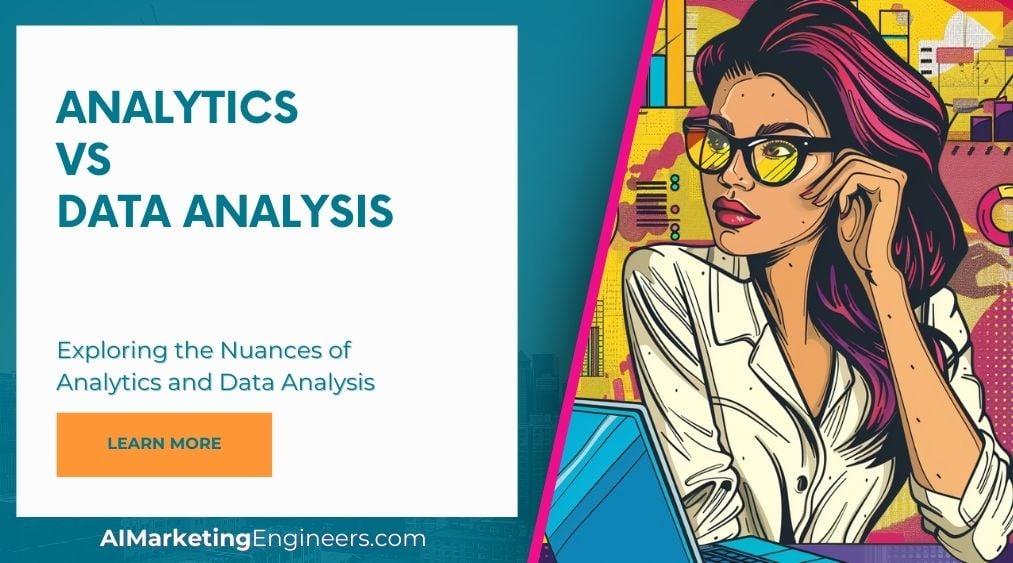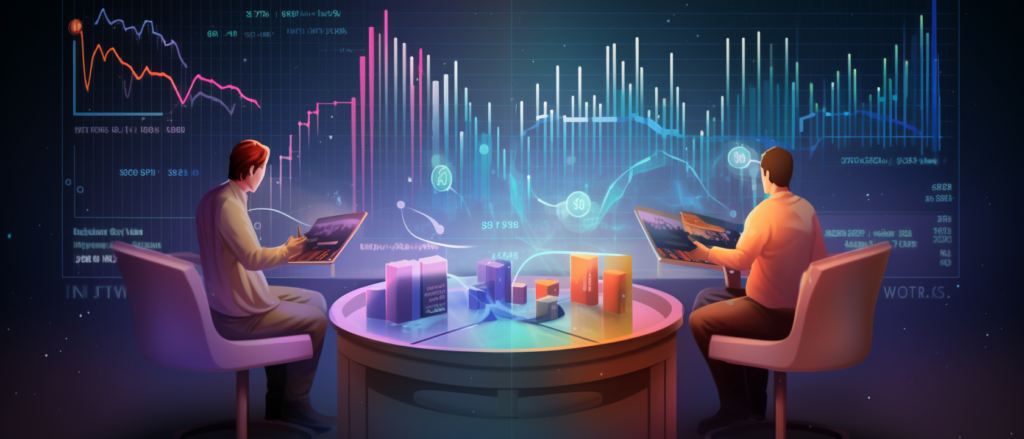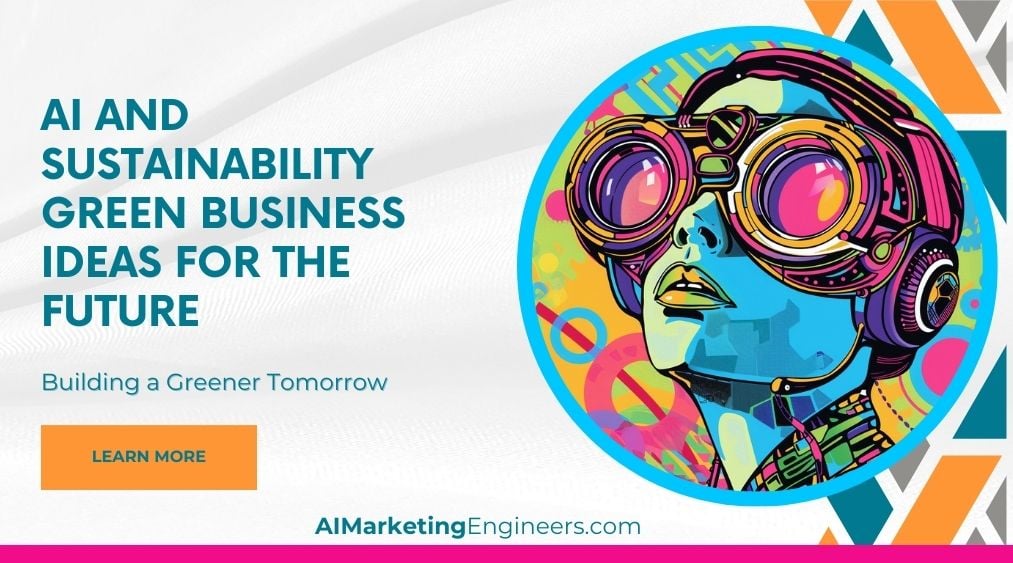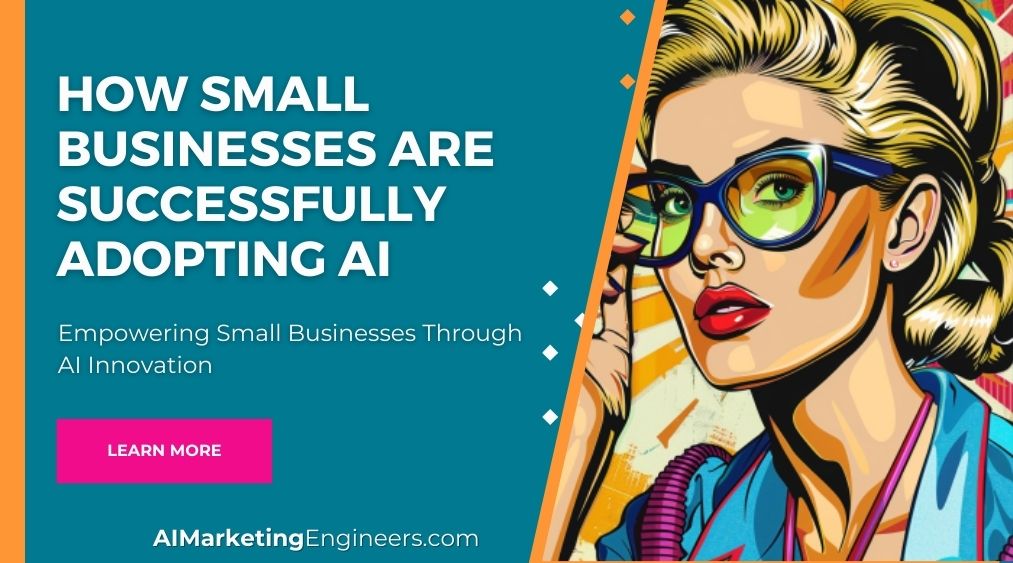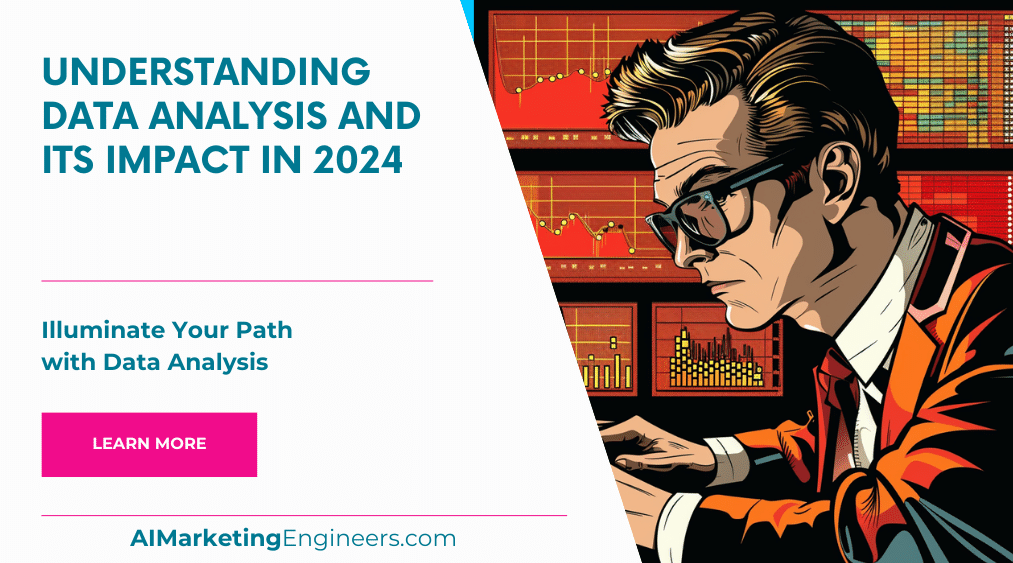Key Takeaways
✅ Definition: Analytics is the multifaceted process of deciphering data through statistical models and visualization, while data analysis is its subset focused on mining raw data for patterns.
✅ Scope and Application: The breadth of analytics stretches to predictive and prescriptive horizons, while data analysis is the bedrock of descriptive summaries.
✅ Business Impact: By unifying analytics and data analysis, companies gain both a telescope to foresee market trends and a microscope to examine current operations.
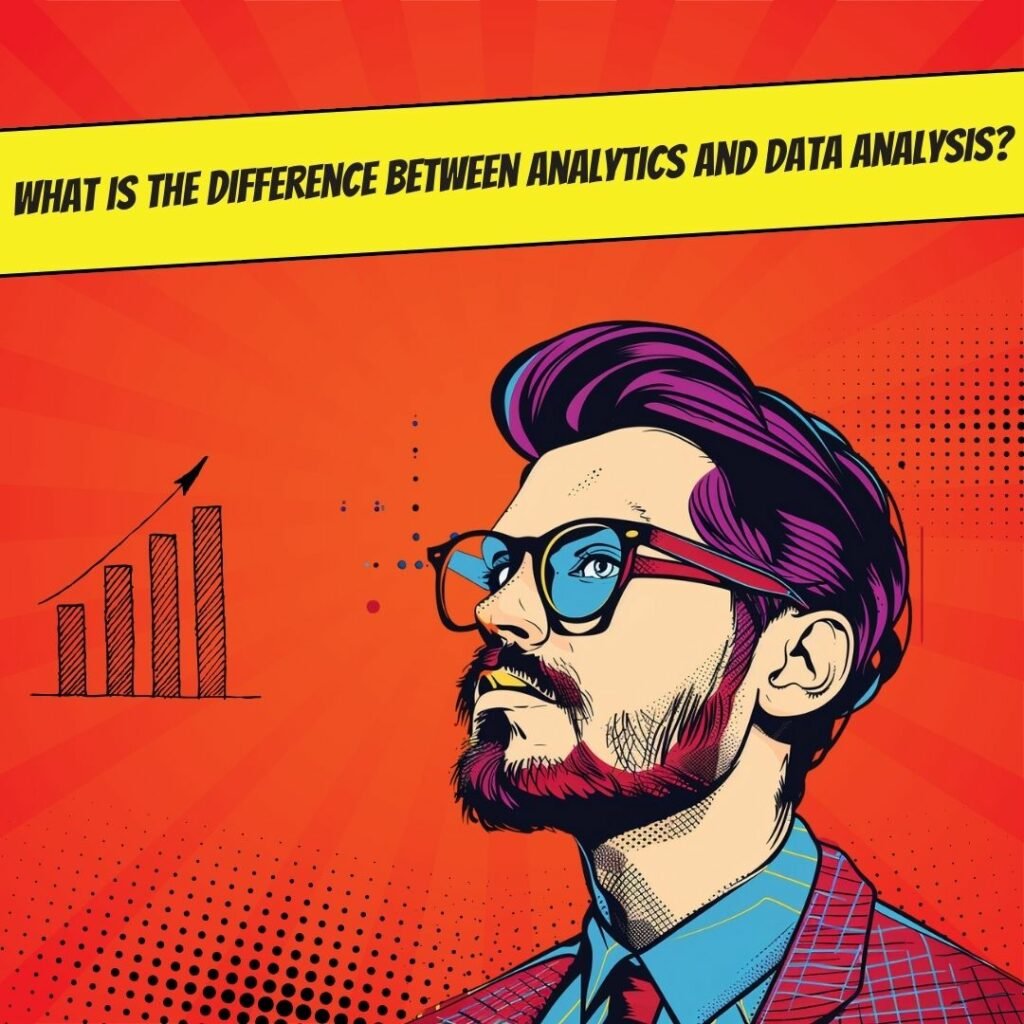
Introduction
Are you ready to harness the power of your data but find yourself tangled in the semantic web of analytics versus data analysis? In an era where data is the new oil, mastering the nuances of these two disciplines is not just a competitive advantage; it’s a business imperative.
This comprehensive guide is designed to help you demystify the subtle yet significant distinctions between analytics and data analysis, presenting a treasure trove of insights that could potentially unlock untapped opportunities for your business. We’ll step through the looking glass to reveal key differences and modern applications, empowering you to leverage these practices to supercharge your revenue, boost your ROAS (Return on Ad Spend), and maximize your ROI (Return on Investment).
By the end of this article, you’ll be equipped with actionable insights and cutting-edge strategies that can transform the way you view and utilize data. Prepare to dive into a world of data-driven innovation that promises not just to inform but to revolutionize your approach to business intelligence and strategy. Welcome to the data revolution – your roadmap to analytics mastery awaits!
Top Statistics
| Statistics | Insight |
|---|---|
| Big Data and Business Analytics Market Size: Valued at $203 billion in 2020 with a CAGR of 13.5% from 2021 to 2028. (Source: Grand View Research, 2021) | An explosive growth trajectory like this illustrates a burgeoning market where e-commerce ventures can harness analytics for strategic competitive advantage. |
| US Global Revenue Share: Approximately 49% in the analytics software market in 2020. (Source: Statista, 2021) | Signals the US as a dominant player in the analytics landscape, serving as a benchmark for e-commerce businesses eying global expansion. |
| Analytics Professionals Demographics: Over half based in North America as of January 2021. (Source: LinkedIn Workforce Report, 2021) | This demographic centralization mandates the need for global businesses to tap into North American expertise or invest in local talent development. |
| Data Science and Analytics Roles: Demand to increase by nearly 364,000 openings by 2025. (Source: Burning Glass Technologies, 2020) | A statistic that profoundly underscores the impetus for businesses to build or scale up their analytics capabilities to meet growing industry demands. |
| Skilled Worker Shortage: Potential shortage of up to 2 million in data science and analytics by 2026. (Source: Deloitte, 2021) | An alarming projection which suggests a pivotal opportunity for those looking to upskill and for companies to invest in training programs. |
Key Differences Between Analytics and Data Analysis
When discussing analytics versus data analysis, it’s paramount to understand that each serves a unique function in the realm of data-driven decision-making. Analytics often encompasses a broader scope, focusing on extracting predictive and prescriptive insights using sophisticated tools such as machine learning algorithms and predictive modeling. It’s future-oriented, aiming to forecast trends and determine actionable strategies. On the flip side, data analysis is more granular and tends to concentrate on descriptive insights, parsing through data to understand what has happened historically in a given context.
The necessary tools and technologies differ as well, with analytics requiring more advanced software capable of handling large datasets and real-time data processing. In terms of expertise, analytics usually demands a deeper understanding of statistical methods and data science principles, while data analysis is grounded in strong mathematical foundations and the ability to interpret data critically.
Analytics: An Overview
Delving into analytics, we identify four primary types: descriptive (what happened), diagnostic (why it happened), predictive (what could happen), and prescriptive (what should we do). Each plays a crucial role in empowering businesses across varying industries. For instance, in marketing, predictive analytics can model customer behavior to optimize campaigns, while in healthcare, prescriptive analytics might suggest personalized treatment plans.
In the toolkit of a data analyst, you’ll find powerful instruments like data visualization platforms, which turn complex data sets into comprehensible insights, as well as machine learning frameworks and statistical modeling techniques that aid in uncovering patterns and informing business strategies.
Data Analysis: Understanding its Core Concepts
Data analysis unfolds in several stages, starting with meticulous data collection, followed by cleansing operations to eradicate inaccuracies, leading up to data transformation for usability, and finally, modeling to extract significant findings before culminating in interpretation. It’s a detailed process that requires the data analysts to navigate through challenges such as missing values and outliers that could skew results.
To conquer these obstacles, an adept analyst brandishes skills such as critical thinking and robust problem-solving capabilities. Proficiency in programming languages like Python or R is also non-negotiable, providing the necessary arsenal for tackling complex data quandaries.
Integrating Analytics and Data Analysis
Symbiotic relationships between analytics and data analysis can drive organizations to new heights of efficiency and success. When these disciplines collaborate, with analytics providing the foresight and data analysis the meticulous detail examination, companies gain a holistic view of their operations and markets.
Best practices for integration include establishing clear communication channels and maintaining alignment on objectives. By examining case studies like Netflix’s recommendation engine, we can appreciate the potent combination of both disciplines in crafting a personalized user experience that has revolutionized content consumption.
Future Trends and Advancements
Looking ahead, a plethora of emerging technologies such as Artificial Intelligence (AI), the Internet of Things (IoT), and edge computing are transforming the landscapes of analytics and data analysis. These technologies are streamlining data processing and widening the scope for real-time, actionable insights.
Potential career paths are blossoming in these fields, with demand for talents such as data scientists and business intelligence analysts ascending steadily. As we propel into the future, we can predict that both analytics and data analysis will continue to evolve, becoming even more integrated and nuanced with the advancement of technology and methodologies.
Inspirational Quotes
1. Data is just like crude oil; unrefined, it cannot really be used. We have to refine it for people to use it. – Clive Humby
2. Analytics isn’t about finding answers; it’s about asking better questions. – Jeff Leek
3. Big data will spell the death of customer segmentation and force the marketer to understand each customer as an individual within 18 months or risk being left in the dust. – Virginia M. Rometty
AI Marketing Engineers Recommendation
Recommendation 1: Implement Predictive Analytics to Craft Personalized Experiences: Embrace Predictive Analytics by integrating machine learning algorithms with your customer data to forecast future buying behaviors and preferences. Recent data shows that personalized recommendations can boost sales by up to 15%. Harness this power by utilizing tools like Google Analytics’s predictive metrics to identify potential high-value customers and tailor your marketing efforts for increased ROI.
Recommendation 2: Leverage Data Analysis for Real-Time Decision Making: Tap into the potential of Real-Time Data Analysis to make swift, informed decisions. In this age of immediacy, the ability to analyze and act on data in real-time is a game-changer. With 62% of executives stating that the use of information (including data and analytics) is creating a competitive advantage for their organizations, ensure your analytics strategy incorporates real-time data streams to respond instantly to customer behavior, market trends, and operational efficiencies.
Recommendation 3: Utilize AI-Powered Analytics Tools for Enhanced Data Analysis: AI-Powered Analytics Tools are transforming e-commerce by automating complex data analysis tasks, enabling business owners to focus on strategic decision-making. With 83% of businesses reporting that AI is a strategic priority in their data analytics, tools like Microsoft’s Power BI or Tableau with integrated AI capabilities should be essential in your toolkit. These platforms can help uncover hidden patterns, offer rich insights, and forecast trends without the need for deep technical expertise, democratizing data and empowering your business to stay ahead of the curve.
Conclusion
In the dynamic world of e-commerce, the contrast and concurrence of analytics and data analysis have crystallized into a compelling narrative of immense value. For businesses to thrive, it’s fundamental to grapple with the nuances distinguishing these two powerful tools. Analytics, with its descriptive, diagnostic, predictive, and prescriptive facets, empowers organizations to venture beyond the horizon of what has occurred, to foresee and shape what could happen. Meanwhile, data analysis provides the bedrock of insights, through meticulous processes, for data-driven decision-making.
Time and again, it’s not just the method but the integration that forges a formidable synergy: analytics extrapolating actionable strategies from the groundwork laid by thorough data analysis. This union has served as a keystone in constructing resilient strategies across various industries, from retail’s cross-channel marketing to healthcare’s patient care enhancement.
Moreover, as we peer into the landscape of emerging technologies, such as artificial intelligence and the Internet of Things (IoT), the potential for analytics and data analysis to redefine and revolutionize is boundless. The proficiency to wield these disciplines is not merely an asset but an imperative to stay ahead of the curve. Enthusiasts and professionals alike should earnestly seek to deepen their understanding, enhance their skills, and stay attuned to the evolving trends in analytics and data analysis. Your curiosity, combined with the knowledge shared in this guide, serves as a beacon guiding towards growth and innovation.
FAQs
Question 1: What is the difference between analytics and data analysis?
Answer: Analytics involves using data insights to make informed decisions, while data analysis focuses on collecting, processing, and organizing raw data into meaningful information. In essence, data analysis forms the foundation for analytics by preparing data for further interpretation and decision-making.
Question 2: Are there different types of analytics and data analysis?
Answer: Yes, both fields have various subtypes. For instance, in analytics, you may encounter descriptive, diagnostic, predictive, prescriptive, and cognitive analytics, each serving distinct purposes. Similarly, data analysis can be categorized into exploratory, confirmatory, inferential, and causal analysis, among others.
Question 3: Which skills are required for analytics and data analysis roles?
Answer: Both disciplines require strong mathematical, statistical, and computational abilities. However, analytics also demands business acumen, communication skills, and strategic thinking, whereas data analysis emphasizes proficiency in programming languages like Python or R, database management systems, and data visualization tools.
Question 4: Can I pursue a career in either field without prior experience?
Answer: Yes, although having some background knowledge is advantageous. You could start by enrolling in online courses, obtaining certifications, participating in boot camps, or learning through self-study resources. Gaining hands-on experience via internships, projects, or volunteer work will help build your portfolio and demonstrate expertise.
Question 5: How do I choose between analytics and data analysis careers?
Answer: Consider your interests, strengths, and career goals. If you enjoy working closely with data and developing technical solutions, data analysis might suit you better. On the other hand, if you prefer applying data insights to solve real-world problems and drive business strategy, consider an analytics role.
Question 6: Is it necessary to have a degree in these fields?
Answer: While not mandatory, a formal education in related subjects such as computer science, mathematics, economics, finance, or business administration can provide a solid foundation. Many professionals also pursue advanced degrees or specializations to deepen their understanding and advance their careers.
Question 7: What are common applications of analytics and data analysis?
Answer: Analytics is widely used across industries including healthcare, finance, marketing, supply chain management, and customer service to identify trends, optimize processes, and improve decision-making. Data analysis supports these efforts by ensuring reliable data collection, cleaning, transformation, and modeling.
Question 8: How does technology impact analytics and data analysis?
Answer: Advancements in artificial intelligence, machine learning, cloud computing, and big data technologies continue to revolutionize both fields. These innovations enable faster, more efficient data processing, complex algorithm development, and sophisticated automation capabilities. Staying up-to-date with emerging tech trends is crucial for success in this dynamic landscape.
Question 9: Where can I find resources to learn more about analytics and data analysis?
Answer: Numerous educational institutions, professional organizations, and online platforms offer training materials, webinars, conferences, books, and publications dedicated to these topics. Some popular resources include Coursera, Udemy, Kaggle, DataCamp, The Harvard Business Review, and industry-specific journals.
Question 10: What are common challenges faced by professionals in analytics and data analysis?
Answer: Challenges include managing large datasets, integrating disparate data sources, addressing privacy concerns, communicating complex results effectively, staying current with evolving technologies, and overcoming organizational resistance to change. Developing robust problem-solving and collaboration skills can help overcome these obstacles.
Academic References
- Moore, J. H. (2014). Data Science and Predictive Analytics: Biomedical and Health Applications. Springer. This insightful book delves into the nuances differentiating data analysis and analytics, positioning data analysis as descriptive in nature, and showcasing analytics as a predictive craft aimed at generating applicable insights.
- Sharda, R., Delen, D., & Turban, E. (2017). Business Intelligence and Analytics: From Big Data to Big Impact. MIT Press. Sharda and co-authors articulate the distinctions between data analysis, business intelligence, and analytics, elaborating on how data analysis answers what transpired, and BI and analytics provide insight into the causality and inform strategic decision-making.
- Kumar, A., & Srivastava, P. (2016). A Comparison Study of Data Mining Techniques for Customer Churn Prediction. IEEE Xplore. In this pragmatic study, Kumar and Srivastava evaluate a spectrum of data mining techniques for predicting customer churn, revealing a marked preference for sophisticated analytics over conventional data analysis for predictive accuracy.
- Feng, L., Jefferson, T., & Simoudis, E. (2017). The Analytics Process Model: An Adapted CRISP-DM Framework for Business Intelligence and Analytics Projects. Springer. The article introduces an evolved CRISP-DM framework, tailored for the dynamic processes of business intelligence and analytics projects, reflecting their iterative nature and outlining a roadmap for implementation.
